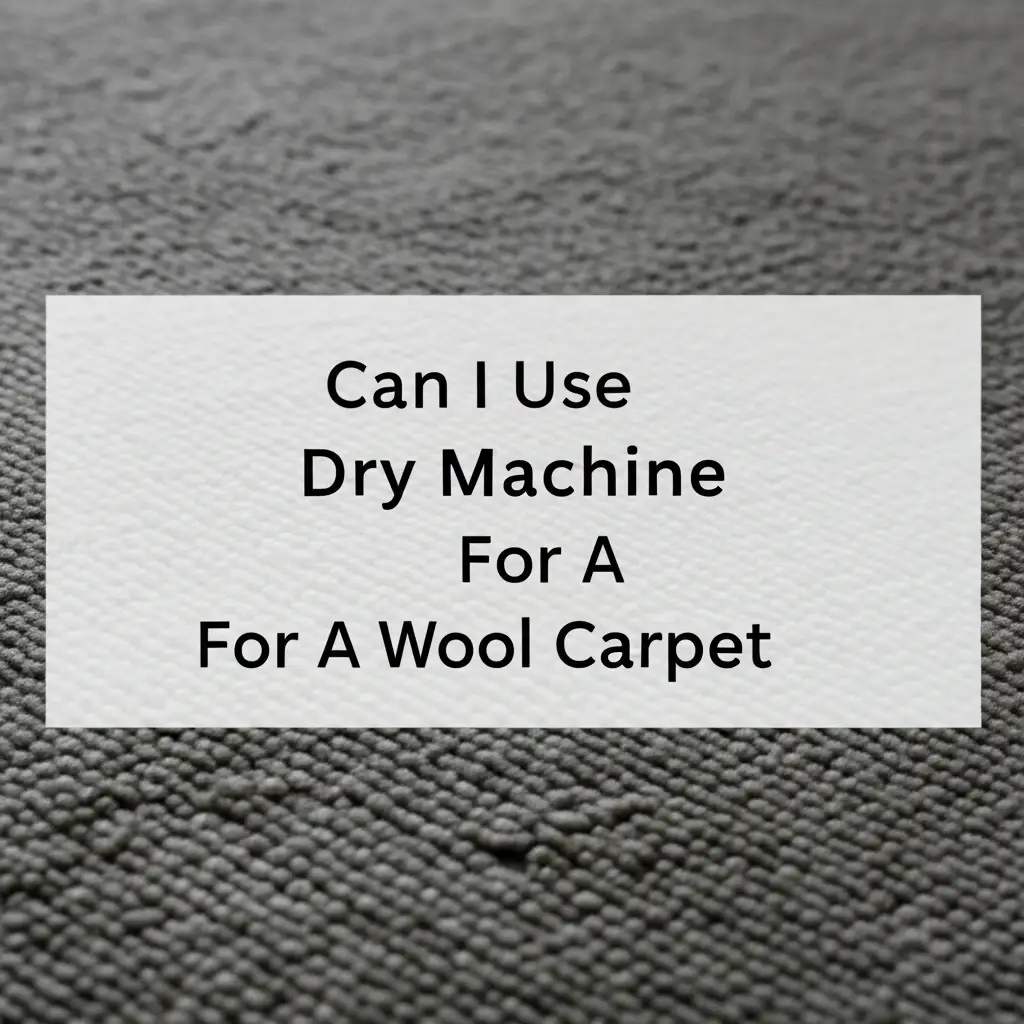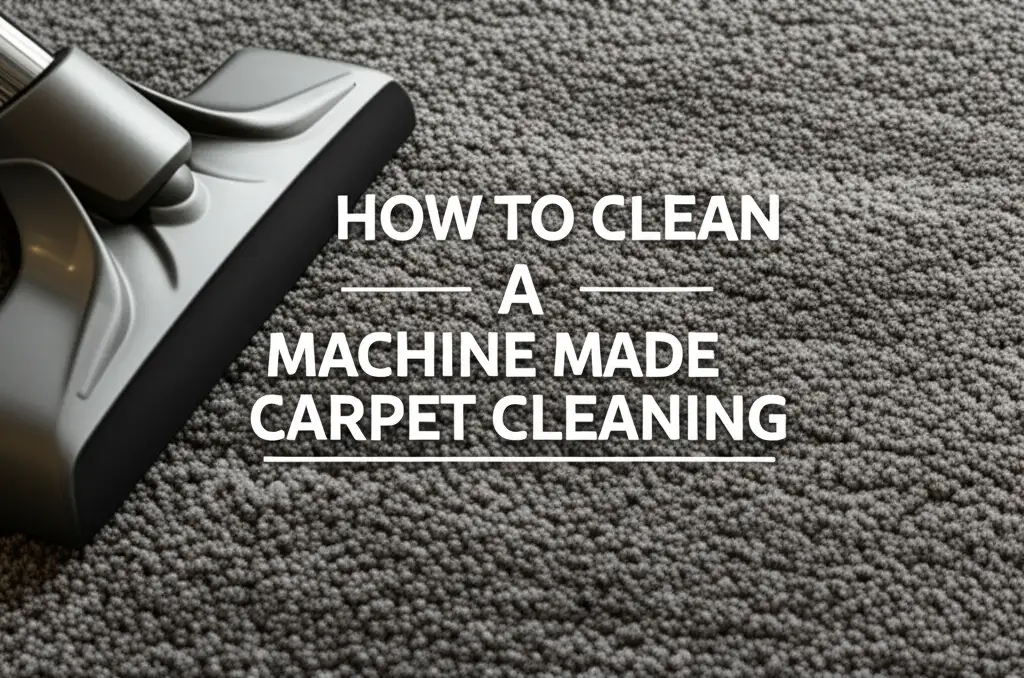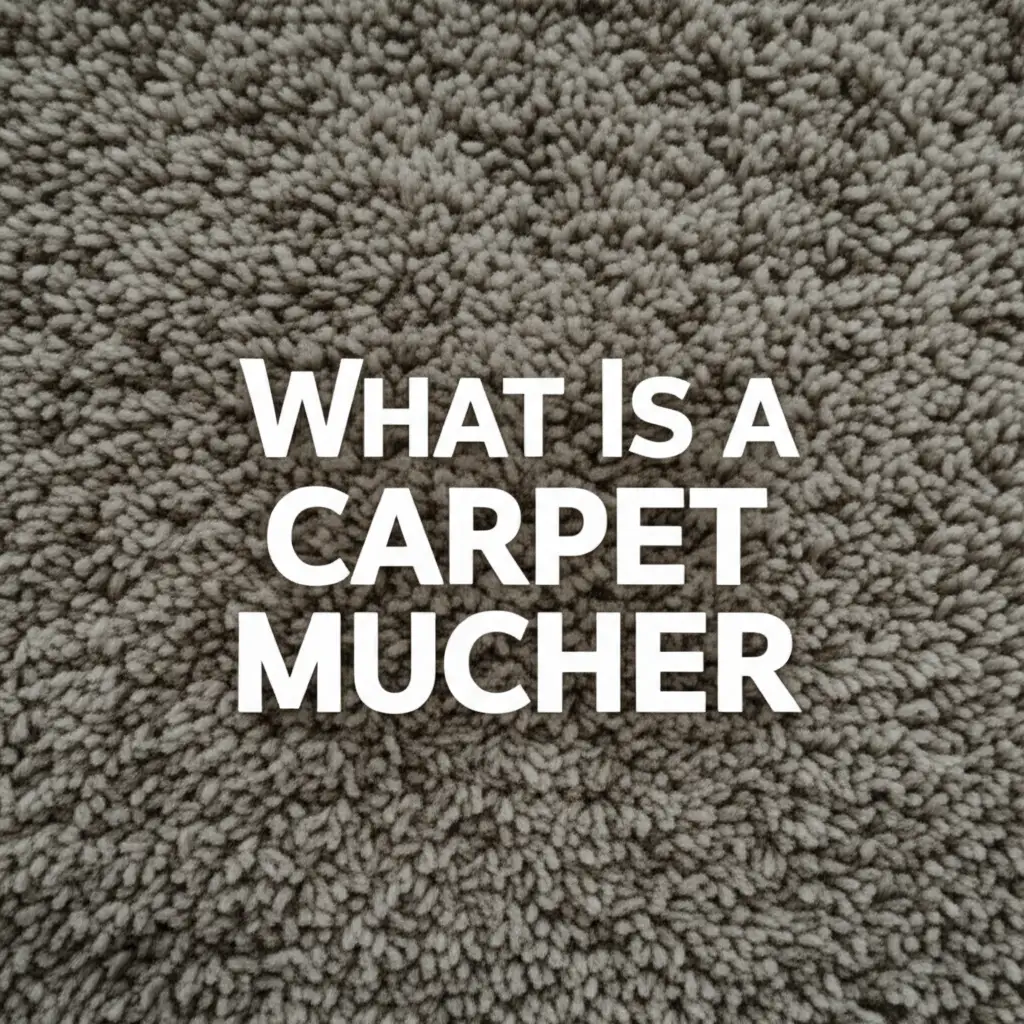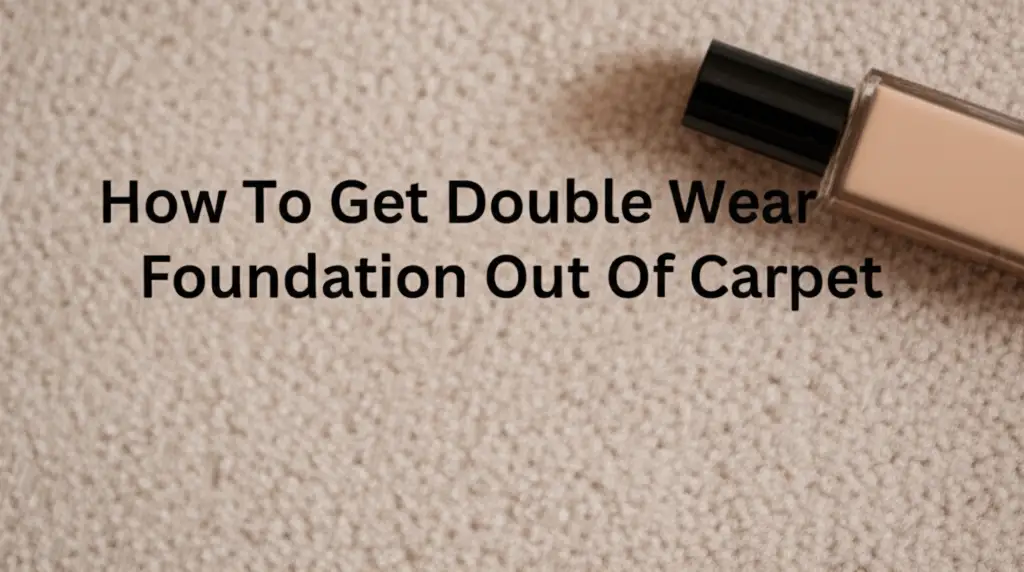· Liora Benning · Carpet Care · 18 min read
Can I Use Dry Machine For A Wool Carpet

Can I Use Dry Machine for a Wool Carpet? Unveiling the Truth
Your beautiful wool carpet adds warmth and elegance to your home. But spills and stains happen, leading you to wonder about the best way to clean it. The question “Can I use a dry machine for a wool carpet?” often comes up. Many people confuse “dry machine” with various cleaning methods. I understand this confusion completely.
This article will clarify what a “dry machine” might mean in the context of carpet cleaning. More importantly, we will explore why specific methods are unsafe for wool. We will cover the delicate nature of wool fibers and the risks of improper cleaning. I will guide you through safe and effective alternatives. You will learn how to maintain your wool carpet’s beauty and longevity.
Takeaway
- Avoid tumble dryers or washing machines: Wool carpets are not designed for machine washing or drying.
- Understand “dry machine” context: It likely refers to a dry cleaning process, not a clothes dryer.
- Professional dry cleaning: Specialized low-moisture or dry compound methods are safe for wool.
- Gentle spot cleaning: Address small spills immediately with approved wool cleaners.
- Regular vacuuming: Protects fibers from abrasive dirt.
Can I use a dry machine for a wool carpet?
No, you should not use a “dry machine” in the sense of a tumble dryer or a home washing machine for a wool carpet. These machines cause severe damage to natural wool fibers. They can lead to shrinkage, felting, and irreversible texture changes. Only professional dry cleaning or very low-moisture methods are suitable for wool.
Understanding Wool Carpet: Its Delicate Nature
Wool carpets are luxurious and durable. They are made from natural protein fibers. These fibers have unique properties that make them both desirable and sensitive. Wool is known for its softness, resilience, and natural stain resistance. However, its natural structure also makes it vulnerable to harsh cleaning methods.
The fibers are made of scales that can interlock when exposed to heat and agitation. This process is called felting. Once wool fibers felt, they become matted and stiff. This damage is usually irreversible. Understanding wool’s delicate nature is the first step in proper care.
The Protein Structure of Wool
Wool fibers are composed of keratin, a protein. This protein is similar to human hair. It has a natural crimp that gives wool its elasticity and bulk. This crimp also traps air, providing insulation. The outer layer of each fiber has microscopic scales. These scales can be damaged by excessive heat, strong chemicals, or harsh agitation.
Maintaining the integrity of these scales is crucial for preserving the carpet’s look and feel. Incorrect cleaning can strip natural oils from the wool. This makes the fibers brittle and less resilient. Proper care respects wool’s inherent characteristics.
Why Wool Reacts Poorly to Harsh Cleaning
When wool is exposed to hot water and vigorous agitation, its scales open up and interlock. This is what causes shrinkage and felting. Standard washing machines use hot water and aggressive tumbling cycles. These conditions are perfect for damaging wool. Household “dry machines” that tumble clothes are equally destructive. They create too much friction and heat.
Even high-moisture steam cleaners can be risky for wool. They can leave too much moisture behind. This moisture can lead to mildew growth and weaken the carpet backing. It is important to remember that wool needs specialized attention.
The Dangers of Using a Dry Machine on Wool Carpets
Using a standard “dry machine” or washing machine on your wool carpet poses significant risks. These appliances are designed for clothes, not large, delicate carpets. The environment within these machines is extremely damaging to natural wool fibers. I have seen many people unknowingly ruin their beautiful carpets this way. It is a common mistake that can be easily avoided.
Irreversible Shrinkage and Felting
One of the most common and devastating outcomes is shrinkage. Wool fibers, when agitated in hot water, contract and bond together. This process, known as felting, permanently reduces the carpet’s size. The carpet may become several inches smaller. It will no longer fit its intended space. The texture also changes, becoming hard and dense like felt. This makes the carpet uncomfortable and unsightly.
Once wool felts, you cannot reverse the damage. The carpet loses its soft, plush feel. It becomes stiff and rigid. This affects both its appearance and its comfort underfoot.
Damage to Carpet Backing and Adhesives
Many carpets have a backing made of materials like jute or synthetic latex. These materials are held together with adhesives. A “dry machine” cycle involves excessive water saturation, heat, and tumbling. This combination can dissolve or weaken these adhesives. The carpet backing may separate from the pile. This can lead to bubbling, delamination, or complete disintegration of the carpet structure.
Water damage can also cause mildew and mold to grow in the backing. This creates unpleasant odors. It also poses health risks. Proper drying is crucial for any carpet, especially wool. You can learn more about drying carpets after cleaning in resources like How Long for Carpet to Dry After Bissell.
Loss of Lanolin and Natural Oils
Wool fibers naturally contain lanolin and other oils. These oils contribute to wool’s natural stain resistance and softness. A “dry machine” cycle, with its detergents and hot water, can strip these beneficial oils away. Without these natural protectors, the wool becomes more susceptible to future stains. It also loses its natural luster and feels rougher to the touch.
This stripping of natural oils diminishes the carpet’s lifespan. It makes the fibers brittle over time. Maintaining the integrity of these natural properties is key to long-term wool carpet health.
Why “Dry Machine” is a Misnomer for Wool Cleaning
The term “dry machine” can be confusing when discussing carpet cleaning. For clothes, a “dry machine” typically refers to a tumble dryer. For carpets, the term might suggest a “dry cleaning” process. However, these are two very different concepts. Understanding this distinction is vital for proper wool carpet care. I often see people mixing these terms, leading to costly mistakes.
Distinction Between Tumble Drying and Professional Dry Cleaning
A tumble dryer, or clothes dryer, uses heat and tumbling to remove moisture from fabrics. This is an extremely aggressive process for a large, heavy wool carpet. The intense heat combined with constant friction will inevitably cause shrinkage and felting. This machine is designed for small, specific loads, not a delicate carpet.
Professional “dry cleaning” for carpets, on the other hand, does not involve a tumble dryer. It refers to methods that use very little or no water. These methods often involve specialized solvents or absorbent compounds. The goal is to clean without saturating the wool. This protects the delicate fibers. You can find more information about professional dry cleaning for carpets at Can You Dry Clean a Carpet.
The Risks of High Heat and Agitation
Wool is highly sensitive to both high heat and mechanical agitation. A clothes dryer or washing machine provides both in abundance. The heat causes the wool fibers to swell. The agitation then forces the scales on the fibers to interlock. This creates a dense, shrunken mass. This process is irreversible and destroys the carpet’s original texture and dimensions.
Even lower heat settings in a dryer are dangerous for wool carpets. The tumbling action alone is too harsh. It stresses the fibers and breaks down their structure over time. This leads to premature wear and damage.
Understanding “Low Moisture” and “Dry Compound” Methods
When professional cleaners talk about “dry cleaning” wool carpets, they usually refer to low-moisture or dry compound methods.
- Low-moisture cleaning uses minimal water, often through foam or mist, immediately extracted. This limits the time wool fibers are exposed to water.
- Dry compound cleaning involves sprinkling a special absorbent powder over the carpet. This powder contains solvents and detergents. It absorbs dirt and grime. The powder is then vacuumed up, leaving the carpet clean and dry. These methods are designed to be safe for wool. They avoid the issues of shrinkage and felting. They are the go-to solutions for delicate carpets.
Safe Dry Cleaning Alternatives for Wool Carpets
Since a “dry machine” in the sense of a tumble dryer is out of the question, what are the safe alternatives? Professional carpet cleaners use specific methods designed to protect wool’s natural fibers. These methods are often referred to as “dry cleaning” or “very low moisture” cleaning. They ensure your wool carpet stays beautiful and lasts for years. I always recommend these specialized approaches.
Professional Low-Moisture Cleaning
Professional low-moisture cleaning methods are excellent for wool carpets. These methods use minimal water. One common technique involves a rotary machine that applies a low-moisture foam or mist. The cleaning solution encapsulates dirt particles. The machine’s pads then absorb the dirt. This process minimizes the amount of water applied to the carpet. It also ensures quick drying times.
This method avoids saturating the carpet backing. It reduces the risk of shrinkage, mildew, and adhesive damage. It is a highly effective way to clean wool without the risks associated with traditional wet cleaning. This method protects the wool’s delicate structure.
Dry Compound Cleaning Method
Another safe and effective “dry” cleaning method for wool carpets is dry compound cleaning. This involves spreading a specialized, absorbent powder over the carpet. The powder contains cleaning agents and a controlled amount of moisture. As the powder works, it attracts and absorbs dirt, grime, and odors from the carpet fibers.
After a dwell time, the cleaner uses a powerful vacuum to remove the saturated compound. The carpet is left clean, refreshed, and completely dry. This method is ideal for wool because it introduces virtually no liquid into the carpet. There is no risk of shrinkage, felting, or extended drying times. This also means you can walk on the carpet almost immediately.
Rotary Shampoo with Controlled Moisture
Some professionals might use a rotary shampoo method, but with very strict moisture control. This is not like traditional wet shampooing. Instead, it uses a low-foaming, wool-safe shampoo solution. The rotary machine uses brushes to agitate the foam. The foam lifts dirt. The key is that very little liquid penetrates the carpet. The foam and suspended dirt are then extracted immediately.
This method requires skilled technicians. They must ensure proper dilution and swift extraction to prevent over-wetting. It’s a more advanced technique for professional use. It is certainly not something you should attempt with a rented machine. For more on specific carpet cleaners, consider articles like Will the Rug Doctor Work on Wool Carpets and How to Clean a Machine Made Carpet Cleaning.
Professional Wool Carpet Cleaning Methods
When your wool carpet needs a deep clean, professional services are the safest bet. They have the right equipment, solutions, and expertise. Professionals understand the nuances of wool. They can choose the best method to protect your investment. I always recommend consulting a professional for significant cleaning tasks.
Advantages of Hiring a Professional
Hiring a professional carpet cleaner offers several key advantages for wool carpets. First, they possess specialized knowledge of wool fibers. They know which cleaning agents are safe and effective. Second, they have industrial-grade equipment. This equipment provides thorough cleaning without over-wetting. Third, professionals can address specific stains and issues. They offer solutions tailored to your carpet’s condition.
Ultimately, professionals ensure the longevity and beauty of your wool carpet. They prevent costly damage that can arise from DIY attempts. Their expertise saves you time and worry.
Understanding the Process
A professional wool carpet cleaning typically starts with a thorough inspection. The technician identifies the carpet’s type, age, and any existing stains or damage. They will then pre-vacuum the carpet to remove loose dirt. Based on the inspection, they choose the most appropriate wool-safe cleaning method. This might be dry compound, low-moisture encapsulation, or a controlled rotary shampoo.
During the cleaning process, they use specialized wool-friendly solutions. These solutions clean without causing shrinkage or damage. After cleaning, they may use powerful air movers to ensure rapid drying. This meticulous approach protects your valuable wool carpet.
Questions to Ask Professional Cleaners
Before hiring a professional, ask specific questions about their wool carpet cleaning process.
- “What method do you use for wool carpets?” Look for answers like ‘dry compound,’ ‘low-moisture encapsulation,’ or ‘wool-safe rotary shampoo.’
- “Are your cleaning solutions pH neutral and safe for wool?” Wool requires a neutral to slightly acidic pH.
- “What experience do your technicians have with wool?”
- “Do you offer a guarantee against shrinkage or damage?”
- “What is your drying process?” Fast drying is crucial.
Asking these questions helps ensure you choose a reputable and knowledgeable cleaner. Your wool carpet deserves the best care. This kind of careful selection applies to any delicate wool rug, as detailed in resources like How Do You Clean an Area Wool Rug or How to Clean a Handwoven Wool Rug.
DIY Spot Cleaning for Wool Carpets
While deep cleaning requires professionals, you can handle small spills and spots yourself. Quick action is key to preventing stains from setting. Remember, gentle methods are always best for wool. I have personally used these techniques to save many spills from becoming permanent stains.
Immediate Action for Spills
Act fast when a spill occurs on your wool carpet. The quicker you address it, the better your chances of full removal.
- Blot, Don’t Rub: Use a clean white cloth or paper towel to blot the spill. Press firmly to absorb as much liquid as possible. Rubbing pushes the spill deeper into the fibers and can spread it.
- Work from Outside In: Start blotting from the outer edge of the spill and work towards the center. This prevents the stain from spreading outwards.
- Change Cloths Frequently: Use fresh, clean sections of your cloth or new paper towels as they become saturated.
Patience is vital during this initial blotting stage.
Using Wool-Safe Cleaning Solutions
For stubborn spots, use a cleaning solution specifically formulated for wool carpets. Look for products labeled “wool-safe” or “pH neutral.” Harsh chemicals or alkaline cleaners can damage wool fibers.
- Test First: Always test the cleaning solution on an inconspicuous area of your carpet first. This ensures it does not cause discoloration or damage.
- Apply Sparingly: Apply a small amount of the solution to a clean cloth, not directly to the carpet.
- Blot Gently: Blot the stained area with the dampened cloth. Do not rub. Continue blotting until the stain lifts.
- Rinse (Minimal Water): Lightly dampen a fresh cloth with plain water and blot the area to rinse away any residue. Again, use minimal water.
- Dry Thoroughly: Place several layers of clean, dry towels over the damp area. Press down to absorb moisture. You can also place a heavy object on top. Allow the area to air dry completely. Use a fan to speed up drying if needed.
Avoiding Common DIY Mistakes
Many common DIY cleaning mistakes can harm wool carpets.
- Over-wetting: Using too much water is the biggest culprit. It leads to long drying times, mold, mildew, and potential shrinkage.
- Using wrong chemicals: Bleach, ammonia, and strong detergents are very damaging to wool. They can cause permanent discoloration and fiber damage.
- Aggressive scrubbing: Scrubbing creates friction that can felt wool fibers. Always blot gently.
- Not testing solutions: Skipping the patch test can lead to irreversible color loss.
Being cautious and using wool-specific products is essential for DIY spot cleaning. For delicate rugs like a vintage wool rug, extra care is required, as discussed in How to Clean a Vantage Wool Rug.
Maintaining Your Wool Carpet’s Longevity
Beyond cleaning, regular maintenance plays a huge role in your wool carpet’s lifespan. Proper care helps preserve its beauty, resilience, and cleanliness. Incorporating simple habits into your routine will make a significant difference. I find that consistent small efforts yield the best long-term results.
Regular Vacuuming Practices
Regular vacuuming is the most important maintenance step for a wool carpet. It removes dry soil, dust, and debris before they can embed deeply into the fibers. Embedded dirt acts like sandpaper, causing premature wear and dulling the carpet’s appearance.
- Frequency: Vacuum high-traffic areas 2-3 times a week. Lower-traffic areas can be vacuumed once a week or every two weeks.
- Vacuum Type: Use a vacuum cleaner with strong suction and adjustable height settings. Avoid vacuums with aggressive beater bars or brush rolls set too low. A beater bar can pull and fuzz wool fibers. For wool, I recommend turning off the beater bar or using a suction-only vacuum. If your vacuum has an adjustable beater bar, set it to the highest pile setting.
- Slow Strokes: Vacuum slowly to allow the suction to pick up all embedded dirt. Overlap your passes to ensure full coverage.
Protecting from Direct Sunlight and Traffic
Sunlight can fade your wool carpet’s colors over time. Rotating rugs or using window coverings can minimize this effect. High foot traffic can also wear down specific areas. Consider using area rugs or runners in entryways and hallways. This distributes wear and protects the main carpet.
Moving furniture occasionally can also prevent permanent indentations and uneven wear patterns. These small adjustments help maintain an even appearance across the carpet.
Dealing with Pet Accidents and Odors
Pet accidents require immediate and thorough attention.
- Blot Urine: Absorb as much urine as possible with clean towels. Press firmly.
- Rinse Gently: Lightly rinse the area with plain cool water (use minimal water) and blot again to remove urine residue.
- Enzymatic Cleaner: Apply a pet-specific enzymatic cleaner designed for wool. These cleaners break down odors and stains. Follow product instructions carefully.
- Dry Thoroughly: Ensure the area dries completely. Use fans or open windows to aid ventilation.
For lingering odors, professional cleaning might be necessary. Regular grooming of pets also reduces shedding and potential accidents. For pet-related issues, also consider pest control, like learning How to Get Rid of Moths in Wool Rugs.
FAQ Section
Can I use a steam cleaner on wool carpet?
Using a steam cleaner on wool carpet is generally not recommended. Steam cleaners use high heat and can inject too much moisture into the wool fibers. This increases the risk of shrinkage, felting, and mildew growth. While some professional machines have very controlled steam settings, typical home steam cleaners are too aggressive for delicate wool. Always opt for low-moisture or dry cleaning methods instead.
What is the best way to dry a wool carpet after cleaning?
The best way to dry a wool carpet after cleaning is through air circulation and minimal heat. After any cleaning, blot up as much moisture as possible with clean towels. Then, use fans, open windows, and increase room temperature to promote airflow. Avoid direct heat from heaters, as this can cause shrinkage. Ensure the carpet is completely dry within 6-12 hours to prevent mold and mildew.
How often should I clean my wool carpet?
The frequency of cleaning depends on traffic and use. For general maintenance, vacuum your wool carpet 2-3 times a week in high-traffic areas and weekly in low-traffic areas. Professional deep cleaning is recommended every 12-18 months for residential wool carpets. For commercial or very high-traffic areas, professional cleaning might be needed more frequently, perhaps every 6-12 months.
Can I use a regular vacuum on a wool carpet?
Yes, you can use a regular vacuum on a wool carpet, but with caution. It is best to use a vacuum with adjustable height settings or one that allows you to turn off the rotating beater bar. A strong beater bar can agitate and fuzz wool fibers, leading to wear over time. Suction-only vacuums or those with a gentle brush attachment are ideal for wool.
What are signs of damage from improper wool carpet cleaning?
Signs of damage from improper wool carpet cleaning include visible shrinkage, a stiff or matted texture (felting), discoloration, yellowing, or browning stains, and unpleasant odors, especially musty smells indicating mold or mildew. The carpet may also feel rougher to the touch or show signs of fiber loss. These damages are often irreversible and indicate that the wool’s delicate structure was compromised.
Is professional cleaning always necessary for wool carpets?
Professional cleaning is not always necessary for minor spills or routine maintenance. You can handle these with immediate blotting and wool-safe spot cleaners. However, for deep cleaning, general grime, or large stains, professional cleaning is highly recommended. Professionals have specialized knowledge, equipment, and cleaning solutions that safely and effectively clean wool carpets without causing damage like shrinkage or felting.
Conclusion
Understanding how to care for your wool carpet is essential for its longevity and beauty. The answer to “Can I use a dry machine for a wool carpet?” is a definitive no, if “dry machine” means a tumble dryer or washing machine. These appliances cause irreversible damage like shrinkage, felting, and structural breakdown. Wool’s delicate protein fibers require a gentle touch.
Instead, always opt for professional low-moisture or dry compound cleaning methods. These specialized techniques protect the wool while effectively removing dirt and grime. For everyday spills, quick action with a wool-safe spot cleaner and gentle blotting will save your carpet. By prioritizing proper wool carpet care, you ensure your investment remains a beautiful, comfortable centerpiece in your home for many years to come. Consult with a professional carpet cleaner to give your wool carpet the expert attention it deserves.





